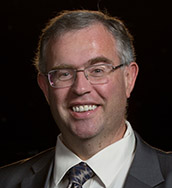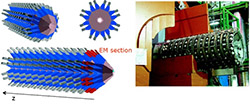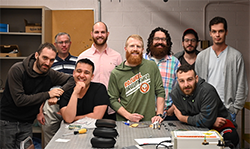Research explores behavior of quarks and gluons at Large Hadron Collider

LAWRENCE — A team of high-energy nuclear experimental particle physicists from the University of Kansas has earned a two-year, $400,000 Department of Energy (DoE) grant to investigate strong interactions between quarks and gluons — building materials for the protons and neutrons that make up an atomic nucleus.
Their work will be carried out using a calorimeter, called CASTOR, which the team recently helped install in the Compact Muon Solenoid (CMS) experiment at the Large Hadron Collider (LHC)— the world’s most powerful atom smasher located in a 17-mile tunnel buried under the border of France and Switzerland. The CASTOR calorimeter can detect particles produced at very small angles relative to the beam direction, making it a unique piece of equipment with no parallel in other experiments at the LHC.
 Christophe Royon, Foundation Distinguished Professor of Physics & Astronomy at KU, is leading the research. He said his team is interested in better grasping a phenomenon called “gluon saturation,” where the standard equations describing the internal structure of the proton do not apply. Indeed, the proton is a composite particle made up of quarks and gluons, the fundamental elementary particles associated with strong nuclear interactions. In a first approximation, the proton is composed of three valence quarks (two up quarks and one down quark). These valence quarks are glued together by the exchange of gluons, the mediator of the strong nuclear force. Gluons are one of the key ingredients for our understanding of how nuclear matter is formed.
Christophe Royon, Foundation Distinguished Professor of Physics & Astronomy at KU, is leading the research. He said his team is interested in better grasping a phenomenon called “gluon saturation,” where the standard equations describing the internal structure of the proton do not apply. Indeed, the proton is a composite particle made up of quarks and gluons, the fundamental elementary particles associated with strong nuclear interactions. In a first approximation, the proton is composed of three valence quarks (two up quarks and one down quark). These valence quarks are glued together by the exchange of gluons, the mediator of the strong nuclear force. Gluons are one of the key ingredients for our understanding of how nuclear matter is formed.
“We want to study a new kind of dynamical regime for protons in which the density of gluons can become much larger,” he said. “You can imagine the subway in New York at rush hour when you have all these people squashed together. You can’t consider each person independently — if something happened to the subway, then it will happen to the full crowd. That’s what happens to heavy ions — collections of about 200 protons and neutrons bound together. You can’t consider all the constituent gluons and quarks to be free inside the ion, but they behave as one.”
 When protons or heavy ions collide at the Large Hadron Collider, the actual collisions occur between their constituent quarks and gluons. The researchers will hunt for evidence of gluon saturation by looking at production of jets, collimated sprays of particles produced in these collisions.
When protons or heavy ions collide at the Large Hadron Collider, the actual collisions occur between their constituent quarks and gluons. The researchers will hunt for evidence of gluon saturation by looking at production of jets, collimated sprays of particles produced in these collisions.
“This is the fraction of the proton momentum carried by the quark or gluon that interact,” Royon said. “When x is very small it means the number of quarks or gluons are getting very large inside the proton, and it means it's a very dense gluonic object. There are many, many gluons inside — so the smaller the x, the larger the more intense the saturation. This what we want to see.”
 According to the researchers, “making a first clear observation at the LHC of gluon saturation would be an outstanding milestone in nuclear physics.”
According to the researchers, “making a first clear observation at the LHC of gluon saturation would be an outstanding milestone in nuclear physics.”
Indeed, Royon’s investigation will contribute to better understanding how nucleons and nuclei form using a theory called “quantum chromodynamics,” or QCD, which is concerned with the strong interaction between quarks and gluons. In this theory, quarks and gluons have the intrinsic physical property of color charge. Color charge in nuclear interactions is analogous to the electric charge in electromagnetic interactions. While quarks and gluons are charged under color, stable particles like the proton are colorless particles.
“This is a way to study how all constituents of matter are interacting together,” he said. “We’re all made of quarks and gluons. The table where I’m sitting, the computer I’m using, all are made of the same constituents. We’re studying the way quarks and gluons interact together because these are the building blocks of all matter. What we study is a special domain not very well known, but it’s important to better understand the structure of protons.”
Royon and his KU team already have collected data at the Large Hadron Collider using the CASTOR detector, and they now are combing the data to search for evidence of gluon saturation. The KU researcher said his team is the largest of the groups from the heavy ion community in the U.S. working at the European particle accelerator.
In addition, Royon's group is interested in a special kind of reaction where large angular regions are void in radiation, known as diffractive reactions. In most collisions at the LHC, due to the exchange of color charge between the colliding quarks and gluons, a lot of radiation is present over large angles in the detector. However, in some cases, multi-gluon exchanges in colorless configurations can take place, leading to large angular regions void of radiation. These reactions can provide complementary insight into the internal structure of the proton and are a good testing ground of predictions by QCD.
In addition, the group has recently started searching for the presence of top quark production in heavy ion collisions. The top quark is the heaviest elementary particle observed in nature — the top quark has the same weight as a gold atom nucleus. This particle has not been observed in heavy ion collisions. The top quark has the potential of providing an additional tool to study the quark-gluon plasma, a state of matter of nearly free quarks and gluons.
“Normally, I have seven doctoral students working with me, and five are members of the CMS collaboration,” Royon said. “Three of them — Cristian Baldenegro, Zach Warner and Cole Lindsey — are working on these pressing problems, and I have one postdoctoral researcher working on heavy ions. Some will spend the summer at CERN, and I will go there three or four times for meetings and conferences per year.”
The KU researcher said his team’s work at the Large Hadron Collider will help guide planning for the Electron-Ion Collider (EIC), a new supercollider planned for the U.S. (either at Brookhaven National Laboratory in Upton, New York, or Thomas Jefferson National Accelerator Facility in Newport News, Virginia) outlined in the DoE’s Long-Range Plan for Nuclear Science.
“The work under this grant is complementary because some of the goals are to do the same kind of physics at the future Electron Ion Collider — looking for gluon-saturation kind of effects,” Royon said.
Royon’s work at the frontier of nuclear physics recently earned him the prestigious Alexander von Humboldt Research Award in Germany. This is the highest prize in that nation for work in science or the humanities. Along with the honor and a cash award, the Humboldt will open doors for research opportunities with collaborators in Germany.
“The award is granted in recognition of a researcher's entire achievements to date to academics whose fundamental discoveries, new theories or insights have had a significant impact on their own discipline and who are expected to continue producing cutting-edge achievements in the future,” according to the Humboldt Foundation. “Professor Royon is a world expert on the high-energy scattering of quarks and gluons and the dynamics of their interactions. His achievements range from the development of ultrafast detectors to important theoretical contributions to the understanding of diffractive processes.”
Royon said the award would support his research at colliders in Europe and the U.S. as well as possibly provide support for postdoctoral researchers on his team.
“The Humboldt Award will allow us to develop new tools in order to study this gluon saturation regime both for the Large Hadron Collider and the Electron Ion Collider in collaboration with Professor Michael Klasen, my host in Münster, Germany," he said.
Top image: The CASTOR detector was integrated into the Large Hadron Collider's Compact Muon Solenoid. Credit: CERN
Top right image: The CASTOR calorimeter can detect particles produced at very small angles relative to the beam direction, making it a unique piece of equipment with no parallel in other experiments at the LHC. Credit: DESY CMS Group
Bottom right image: Christophe Royon's KU research team. From left to right: Federico Deganutti (Italy), Christophe Royon (France), Cristian Baldenegro (Mexico), Justin Williams (U.S.), Zachary Warner (U.S.), Cole Lindsey (U.S.), Tommaso Isidori (in front) (Italy), Georgios Krintiras (Greece) and Guillaume Biagi (France). Credit: Christophe Royon.